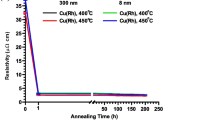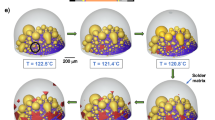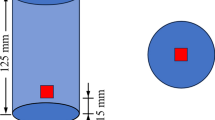Abstract
The growth behavior of reaction-formed intermetallic compounds (IMCs) at Sn3.5Ag0.5Cu/Ni and Cu interfaces under thermal-shear cycling conditions was investigated. The results show that the morphology of (Cu x Ni1–x )6Sn5 and Cu6Sn5 IMCs formed both at Sn3.5Ag0.5Cu/Ni and Cu interfaces gradually changed from scallop-like to chunk-like, and different IMC thicknesses developed with increasing thermal-shear cycling time. Furthermore, Cu6Sn5 IMC growth rate at the Sn3.5Ag0.5Cu/Cu interface was higher than that of (Cu x Ni1–x )6Sn5 IMC under thermal-shear cycling. Compared to isothermal aging, thermal-shear cycling led to only one Cu6Sn5 layer at the interface between SnAgCu solder and Cu substrate after 720 cycles. Moreover, Ag3Sn IMC was dispersed uniformly in the solder after reflow. The planar Ag3Sn formed near the interface changed remarkably and merged together to large platelets with increasing cycles. The mechanism of formation of Cu6Sn5, (Cu x Ni1–x )6Sn5 and Ag3Sn IMCs during thermal-shear cycling process was investigated.








Similar content being viewed by others
References
J.Y. Tsai and C.R. Kao, The Effect of Ni on the Interfacial Reaction Between Sn-Ag Solder and Cu Metallization, Proceedings of the 4th International Symposium on Electronic Materials and Packaging Conference (Taiwan, China), IEEE Press, 2002, p 271–276
Y. S. Kim, K.S. Kim, C.W. Hwang, et.al. (2003)Effect of compositipm and cooling rate on microstructure and tensile properties of Sn-Zn-Bi alloys J. Alloys and Compd., 352(3):237–245.
X. Ma, F.J. Wang, Y.Y. Qian, et.al. Development of Cu-Sn intermetallic compound at Pb-free solder/Cu joint interface Materials Letters, 2003, 57(22-23): 3361-3365.
K.S. Kim, J.M. Yang, C.H. Yu, I.O. Jung, et.al. Analysis on interfacial reactions between Sn-Zn solders and the Au/Ni electrolytic-plated Cu pad. J. Alloys and Compd. (2004) 379(1/2): 314-318.
C.L. Wei and C.R. Kao, Liquid/Solid and Solid/Solid Reactions Between SnAgCu Lead-Free Solders and Ni Surface Finish, Proceedings of the 4th International Symposium on Electronic Materials and Packaging Conference (Taiwan, China), IEEE Press, 2002, p 330–334
C.M. Chang, P.C. Shi, and K.L. Lin, Interfacial Reaction Between Sn-Ag-Cu, Sn-Ag-Cu-Ni-Ge Lead-Free Solders and Metallic Substrates, Proceedings of the 4th International Symposium on Electronic Materials and Packaging Conference (Taiwan, China), IEEE Press, 2002, p 360–366
H.L.J. Pang, K.H. Tan, X.Q. Shi, and Z.P. Wang, Microstructure and Intermetallic growth effects on shear and fatigue strength of solder joints subjected to thermal cycling aging. Mat. Sci. Eng. A-struct 307 (2001) 42-50.
Ahmed Sharif, Y.C.Chan, M.N.Islam, M.J.Rizvi. Effect of indium addition in Sn-rich solder on the dissolution of Cu metallization. J. Alloys and Compd. 388 (2005) 75-82.
S. Wiese, F. Feustel, E. Meusel, Characterisation of constitutive behaviour of SnAg, SnAgCu and SnPb solder in flip chip joints. Sensors and Actuators A99 (2002) 188-193.
K.H. Prakash, T. Sritharan. Interface reaction between copper and molten tin-lead solders. Acta mater. 49 (2001): 2481-2489.
O. Fouassier, J. Chazelas, J.F. Silvain. Conception of a consumable copper reaction zone for a NiTi/SnAgCu. Composite Material. Part A, 2002 (33): 1391-1395.
L. Qin, J. Zhao, L. Wang. et.al. Microstructure evolution in lead-free solder joints after wave soldering and reflow soldering. Electronic Process Technology 2004,25(2):64-67.
H.L.J. Pang, T.H. Low, B.S. Xiong, et.al. Thermal cycling aging effects on Sn-Ag-Cu solder joint microstucture, IMC and strength. Thin Solid Films 462-463(2004): 370-375.
I. Dutta, D. Pan. R.A. Marks, et.al. Effect of thermo-mechanically induced microstructural coarsening on the evolution of creep response of SnAg-based microelectronic solders. Materials Science and Engineering A, 2005, 410-411(25):48-52.
J. Zhao, Y.Miyashita, Y.Mutoh. Fatigue crack growth behavior of 96.5Sn-3.5Ag lead-free solder. International Journal of Fatigue, 2001(23): 723-731.
D.W. Henderson, T. Gosselin, A. Sarkhel. Ag3Sn plate formation in the solidification of near ternary eutectic Sn-Ag-Cu alloys. J. Mater. Res. 17 (2002): 2775-2778.
K.S.Kim, S.H.Huh, K.Suganuma. Effect of intermetallic compounds on properties if Sn-Ag-Cu lead-free soldered joints. J. Alloys and Compd., 2003(352): 226-236.
Acknowledgment
This work was supported by the National Natural Science Foundation of China (No. 50371010).
Author information
Authors and Affiliations
Corresponding author
Rights and permissions
About this article
Cite this article
Qi, L., Huang, J., Zhang, H. et al. Growth Behavior of Intermetallic Compounds at SnAgCu/Ni and Cu Interfaces. J. of Materi Eng and Perform 19, 129–134 (2010). https://doi.org/10.1007/s11665-009-9423-9
Received:
Revised:
Accepted:
Published:
Issue Date:
DOI: https://doi.org/10.1007/s11665-009-9423-9




